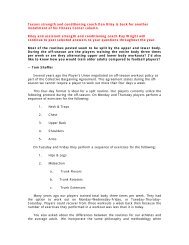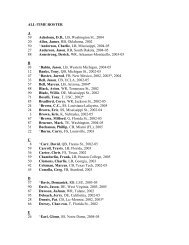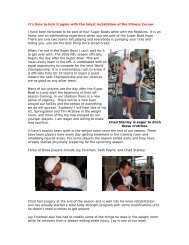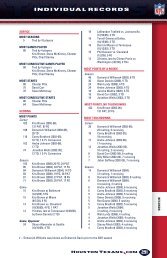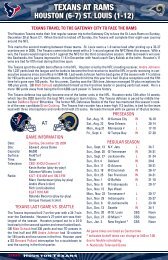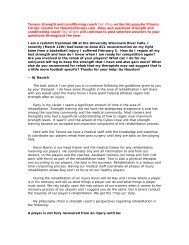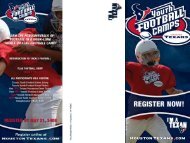Dan Riley's latest installment of Texans Fitness - Houstontexans ...
Dan Riley's latest installment of Texans Fitness - Houstontexans ...
Dan Riley's latest installment of Texans Fitness - Houstontexans ...
Create successful ePaper yourself
Turn your PDF publications into a flip-book with our unique Google optimized e-Paper software.
Welcome to <strong>Dan</strong> Riley’s <strong>latest</strong> <strong>installment</strong> <strong>of</strong> <strong>Texans</strong> <strong>Fitness</strong> Corner. Theresponse continues to be overwhelming. We will continue to post selectedanswers to your questions throughout the year.NOTE: Before engaging in any new physical activity, always consult your physician.I am a strength coach at a high school in Cincinnati. I read an article youhad written for Coach magazine. The article discussed a 10-8-6 workout.Can you give me a little background on that routine and compare it to a oneset <strong>of</strong> failure routine?-- Ed, CincinnatiOne <strong>of</strong> the problems <strong>of</strong> writing something for publication is that people might read it.Once it is in print it becomes part <strong>of</strong> your legacy forever. There are some things Ihave changed through the years and will continue to change if facts becomeavailable to dictate a change.For example, in their book, “The Seven Minute Rotator Cuff Solution,” the authorsdescribe in vivid detail the gradual structural degradation that occurs to the shouldercapsule from performing the following movements; lat pulldowns behind the neck,seated presses behind the neck, and upright rows. In the past I had publishedmaterial that included each <strong>of</strong> these movements as part <strong>of</strong> our exercise regimen.I now discourage these movements because <strong>of</strong> the medical justification againstperforming them. I’ve had coaches and former players remind me that I onceadvocated these activities. As I stated earlier, put something in writing and itbecomes part <strong>of</strong> your legacy.I encourage variety in our program. We promote variety by changing the order <strong>of</strong>exercise, the exercises performed, the equipment used to perform the exercise, andthe manner in which the exercise is performed. For several years I employed aroutine that included among other exercises, the bench press, the incline press, andthe seated press. Three sets <strong>of</strong> each exercise were performed. We called it “The 10 -8 - 6 routine.”The sets consisted <strong>of</strong> 10 reps, 8 reps, and 6 reps. It’s a standard routine used bymany coaches. It is a workout popularized by Dr. Greg Shepherd (Bigger, Faster,Stronger).When our players used this routine they would complete 10 reps <strong>of</strong> an exercise withmaximum or near maximum weight. They would wait 1½ minutes and perform asecond set <strong>of</strong> 8 reps, again with maximum or near maximum weight.The amount <strong>of</strong> weight used on the second set would decrease (must decrease if theeffort on the first set was all out or near all out). Our players would wait 1½ minutesand perform a third and final set <strong>of</strong> 6 reps.We use the Electric Coach to document information. The Electric Coach is a computerprogram used to track and store workout data. Mike Gittleson, current strengthcoach at the University <strong>of</strong> Michigan, designed it.
We recorded the 10 - 8 - 6 routine for several years. One year we experimented withthis routine by eliminating the third set <strong>of</strong> 6 reps. We called it our “10 - 8 routine”(pretty innovative huh?).At the end <strong>of</strong> the year we observed our players were getting the same results byperforming two quality sets <strong>of</strong> 10 and 8 reps, as they did with the 10 - 8 - 6 routine.We decided to permanently eliminate the third set <strong>of</strong> 6 reps. It saved both time andenergy.We have several 10 - 8 routines using different equipment. For example, we have adumbbell 10 - 8 routine, and a Smith machine 10 - 8 routine. The only differencebetween these two routines is when performing the bench press, the incline press, orthe seated press; our players will use either dumbbells or a Smith machine. Varyingthe equipment is one way to create variety.Our players will perform one set <strong>of</strong> 10 reps (rest 90 seconds) followed by a set <strong>of</strong> 8reps. This includes a volume <strong>of</strong> 18 reps for each exercise, a total <strong>of</strong> 54 reps for allthree exercises. Keep in mind these routines include other exercises but it is only thebench, incline, and seated press that our players perform 10 & 8 reps.In your question Ed, you asked me to compare our 10 - 8 - 6 (we now use a 10 - 8)routine to a single set routine.We also have a single set dumbbell and Smith machine routine to complement our10 - 8 routines (more variety). We call these routines the Dumbbell Elevator and theSmith Machine Elevator.Our zero to 90-degree adjustable benches can be set at five different angles. We calleach angle a “Floor.” The “First floor,” indicates the adjustable bench is set at zerodegrees. This will allow our players to perform a flat back (supine) bench press onthe Smith machine or with dumbbells.After completing an all out set <strong>of</strong> 10 reps on the First Floor, the athlete moves to anexercise for the upper back. He then returns to the adjustable bench to perform a seton the Second Floor. We raise the adjustable bench up one setting. The angle issomewhere between a flat back bench press and an incline press.The lifter performs an all out set <strong>of</strong> ten reps on the second floor and moves to anexercise for the posterior deltoid. The player then returns to the adjustable benchand raises it one setting higher to the Third Floor (the angle is comparable to anincline press).Upon completion <strong>of</strong> ten reps on the Third Floor our players perform an isolationexercise for the shoulders and then returns to the adjustable bench. The bench israised one more setting to the Fourth Floor (this angle is somewhere between anincline press and a seated press). The last exercise (seated press) is performed onthe Fifth floor.In your question you asked me to compare our 10 - 8 routine, to our one set t<strong>of</strong>ailure routine. With quality exercise the concern is always the volume <strong>of</strong> workperformed. Too much quality exercise will prevent recovery.
The amount <strong>of</strong> work performed in each <strong>of</strong> these routines (10 - 8 or the Elevators) isthe same.As I mentioned earlier, the total number <strong>of</strong> pushing reps (bench press, incline press,seated press) in the 10 - 8 routine is 54 reps. The total number <strong>of</strong> pushing reps ineither <strong>of</strong> the Elevator routines is 50 reps (one set <strong>of</strong> ten reps on each Floor).The volume <strong>of</strong> work performed (total number <strong>of</strong> reps) between our 10 - 8 routinesand our single set routines, is nearly identical.Take my advice Ed, hop on the Elevator and go for a ride! If the Elevator is full, spiceup your day with a little “10 - 8” action.For many years you have advocated “whole body” training routines (upperand lower body performed during the same workout). The last few years itappears that most <strong>of</strong> your players perform split routines (neck and upperbody one day, hips, legs, & midsection the next).Why the change in philosophy? Have you found better results with a splitroutine vs. a whole body routine? Doesn’t the extra time spent in the weightroom with a split routine impinge on the athlete’s recovery? Would youadvocate a split routine <strong>of</strong> this type for high school players or for generalfitness minded people?-- Jim, Pottstown, PAWhenever I have the chance to meet with college students, I explain to them thatthey should gather as much theoretical information as they can find. This will helpthem justify how they organize and implement their own strength and conditioningprograms when they become a coach.In the classroom and laboratory, teachers and researchers have the luxury <strong>of</strong> makingdecisions in a clinical antiseptic setting. When they become coaches students will beforced to make decisions in a practical setting (the real world). They will quicklylearn there are many obstacles to overcome regarding the administration <strong>of</strong> astrength and conditioning program.In his book “The Stress <strong>of</strong> Life,” author Hans Selye discusses his General AdaptationSyndrome (GAS) theory. It is the foundation <strong>of</strong> the “Double Progressive ResistanceTheory.” Oversimplified it states, stress a muscle and it will adapt …. stress it toomuch and failing adaptation occurs.Selye states the body has only one system to recover from any stress. The body isconstantly expending energy and it is also working continuously to replenish thisenergy. Athletes use the same energy system to recover from; practice, games,weight lifting, running, injuries, a cold, an illness, a lack <strong>of</strong> sleep, and many otherenergy depleting activities.In your question you asked, “Doesn’t the extra time spent in the weight room with asplit routine impinge on the athlete’s recovery?” Our players perform the samenumber <strong>of</strong> exercises when we split a routine or if they perform all <strong>of</strong> the exercises in
one workout. Therefore the accumulative amount <strong>of</strong> time spent in the weight room,and the amount <strong>of</strong> energy expended, will be the same.What might impinge on the player’s ability to recover, is performing too muchexercise on successive days.In the past I advocated performing all strength-training exercises (total bodyworkout) in one exercise session. I believed this would allow the body the next dayor two to completely recover from the workout.Splitting the routine forces the body to expend energy on consecutive days. Differentbody parts are trained on alternate days, but the same energy system is used.Athletes don’t have an upper body energy tank and a lower body energy tank.I’ve mentioned in prior installations “In-season Training” is the period <strong>of</strong> the year toemphasize training the most. During the season is the most difficult time toadminister a strength program. Our players spend endless hours meeting, practicing,playing the game, traveling to away games, and trying to find time for their personallife.Our players will perform an intense total body workout on Monday, the day after agame. They will be tired and sore from the Sunday game. The lifting session will helpalleviate the soreness and serve as the first workout for that week.On Wednesday, Thursday, or Friday morning, our players will complete a secondupper body only workout before practice. They will complete a second lower bodyworkout after practice. This schedule works best for our players.Should all athletes use this same plan? My advice to you and all coaches is to adaptto your particular setting and try to do what is best for your athletes.As I mentioned earlier there are many things that interfere with an ideal trainingregimen. All athletes and coaches must adapt and design a plan that best preparesthe athlete to compete. I don’t know if splitting a routine compromises maximumgains and complete recovery. Strength coaches may have to adjust the amount <strong>of</strong>exercise their athletes perform (to prevent over-training).You asked, “do we get better results with a total body or a split-routine?” My opinionis I don’t think it makes a difference. Again I would defer to personal preference orthe circumstances dictated by your athlete’s schedule.



